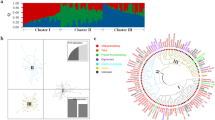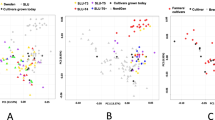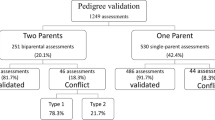Abstract
Pedigree analysis of the 77 advanced Indian potato selections showed that their origin could be traced to only 49 ancestors out of which 29 were exotic, which accounted for 69.52% of the total genomic constitution and maximum contribution (40.65%) was by 10 ancestors from U.K. Breeders’ tendency was to involve adapted advanced clones as immediate parents. Coefficient of relationship between pair of selections ranged from 0 to 0.68. The success of the parents used was not related to region-specific choice of parents. The findings are discussed in the context of “genetic uniformity” and the relevance of having separate breeding programmes for the three major areas of potato cultivation in India. Attempt has also been made to give some directions for choosing selections for use as parents and release as cultivars based on their coefficient of relationship so as to broaden the genetic base of the future potato cultivars.
Similar content being viewed by others
References
Barone, A., 2004. Molecular marker-assisted selection for potato breeding. Am J Potato Res 81: 111–117.
Bourke, A., 1991. Potato blight in Europe in 1845. The scientific controversy. In: J.A Lucas, R.C. Shattock, D. Shaw & L.R. Cooke (Eds.). Phytophthora. pp. 12–24. Cambridge University Press, Cambridge, U.K.
Chang, T.T., 1984. Conservation of rice genetic resources: Luxury or necessity? Science 224: 251–256.
Committee on Genetic Vulnerability of Major Crops. 1972. Genetic vulnerability of major crops. Natl Acad Sci, Washington, D.C.
Cowen, N.M. & K.J. Frey, 1987. Relationships between genealogical distance and breeding behaviour in oats (Avena sativa L.). Euphytica 36: 413–424.
Cox, T.S., Y.T. Kiang, M.B. Gorman & D.M. Rodgers, 1985. Relationships between coefficient of relationship and genetic similarity indices in the soybean. Crop Sci 25: 529–532.
Cox, T.S., J.P. Murphy & D.M. Rodgers, 1986. Changes in genetic diversity in the red winter wheat regions of the United States. Proc Natl Acad Sci U.S.A. 83: 5583–5586.
CPRI, 2003. Annual Report, Central Potato Research Institute, Shimla. pp. 97.
Cubillos, A.G. & R.L. Plaisted, 1976. Heterosis for yield in hybrids between S. tuberosum ssp. tuberosum and tuberosum ssp. andigena. Am Potato J 53: 143–150.
Damerval, C., Y. Hebert & D. de Vienne, 1987. Is the polymorphism of protein amounts related to phenotypic variability? A comparison of two-dimensional electrophoresis data with morphological traits in maize. Theor Appl Genet 74: 194–202.
Delannay, X., D.M. Rodgers & R.G. Palmer, 1983. Relative genetic contributions among ancestral lines to North American soyabean cultivars. Crop Sci 23: 944–949.
Falconer, D.S. & T.F.C. Mackay, 1996. Introduction to Quantitative Genetics 4th edn., pp. 153, Longman, Essex, U.K.
Fonesca, S. & F.L. Patterson, 1968. Hybrid vigor in a seven parent diallel cross in common winter wheat. Crop Sci 8: 85–88.
Glendinning, D.R., 1979. Enriching the potato gene pool using primitive cultivars. In: van A.M. Harten and A.C. Zeven (Eds.). Broadening the Genetic Base of Crops, pp. 39–45. Pudoc, Wageningen, The Netherlands.
Glendinning, D.R., 1997. Estimating of inbreeding in potato pedigrees. Potato Res. 40: 277–284.
Gopal, J. & G.S. Kang, 1988. Three new potato varieties for the plains. Ind Farm 38: 3–4.
Gopal, J., 1997. Progeny selection for agronomic characters in early generations of a potato breeding programme. Theor Appl Genet 95: 307–311.
Gopal, J. & P.C. Gaur, 1997. Potato genetic resources in India. Ind J Plant Genet Resour 10: 205–215.
Gopal, J. & J.L. Minocha, 1997. Genetic divergence for cross prediction in potato. Euphytica 97: 269–275.
Gopal, J., 1999. In vitro versus in vivo genetic divergence in potato. Theor Appl Genet 98: 299–304.
Gopal, J., G.S. Chahal & J.L. Minocha, 2000. Progeny mean, heterosis and heterobeltiosis in Solanum tuberosum × tuberosum and S. tuberosum × andigena families under a sort day sub-tropic environment. Potato Res 43: 61–70.
Gopal, J. & V. Kumar, 2002. Potato gene bank: Its role in developing improved cultivars. Ind Hort 47: 34–36.
Gopal, J., V. Kumar & S.K. Sandhu, 2003. Biosystematics and genetic resources of potato. In: S.M. Paul Khurana, J.S. Minhas & S.K. Pandey (Eds.) The Potato: Production and Utilization in Sub-Tropics, pp. 31–47. Mehta Publishers, New Delhi, India.
Gopal, J., S.K. Pandey & S.M. Paul Khurana, 2004. Utilization of germplasm in the development of Indian potato varieties. Ind J Plant Genet Resour (communicated).
Hawkes, J.G., 1979. Genetic poverty of the potato in Europe. In: Proc Conf Broadening Genetic Base of Crops (1978). pp. 19–27. Wageningen, The Netherlands.
Hougas, R.W., 1956. Foreign potatoes, their introduction and importance. Am Potato J 33: 190–198.
Kishore, H., 1974. The present status and approaches to the potato breeding in India. J Ind Potato Assoc 1: 11–18.
Knauft, D.A. & D.W. Gorbet, 1989. Genetic diversity among peanut cultivars. Crop Sci 29: 1417–1422.
Lefort-Bunson, M., Y. Dattėe & B. Guillot-Lemoine, 1986. Heterosis and genetic distance in rapeseed (Brassica napus L.): Use of kinship coefficient. Genome 29: 11–18.
Lin, M.S., 1991. Genetic base of japonica rice varieties released in Taiwan. Euphytica 56: 43–46.
Loiselle, F., G.C.C. Tai & B.R. Christie, 1991. Pedigree, agronomic and molecular divergence of parents in relation to progeny performance in potato. Potato Res 34: 305–316.
Marani, A. & E. Avieli, 1973. Heterosis during the early phases of growth in intraspecific and interspecific crosses of cotton. Crop Sci 13: 15–18.
Mendoza, H.A. & F.L. Haynes, 1974. Genetic relationship among potato cultivars grown in the United States. Hort Sci 9: 328–330.
Murphy, J.P., T.S. Cox & D.M. Rodgers, 1986. Cluster analysis of red winter wheat cultivars based upon coefficients of parentage. Crop Sci 26: 672–676.
Ortiz, R., 2001. The state of the use of potato genetic diversity. In: H.D. Cooper, C. Spillane & T. Hodgkin (Eds.), Broadening the Genetic Base of Crop Production, pp. 181–200. FAO, IPGRI, CABI Publishing, CAB International, Wallingford, U.K.
Pal, B.P. & Pushkarnath,1951. Indian potato varieties. ICAR, Misc. Bull. 62: 63.
Paterniani, R. & J.H. Lonnquist, 1963. Heterosis in interracial crosses of corn (Zea mays L.). Crop Sci 2: 504–507.
Plaisted, R.L. & R.W. Hoopes, 1989. The past record and future prospects for the use of exotic potato germplasm. Am Potato J 66: 603–627.
Pushkarnath, 1976. Potato in sub-tropics. Orient Longman, New Delhi.
Rodgers, D.M., J.P. Murphy & K.J. Frey, 1983. Impact of plant breeding on the grain yield and genetic diversity of spring oats. Crop Sci 23: 737–740.
Ross, H., 1986. Potato breeding – Problems and perspectives. Adv in Plant Breed 13: 132.
Sanford, J.C. & R.E. Hanneman Jr., 1982. A possible heterotic threshold in the potato and its implications for breeding. Theor Appl Genet 70: 306–308.
Shivkumar, L., V. Subba Rao, T. Ram, N.D. Majumder, G. Padmavathi, U. Prasada Rao & K. Krishnaiah. 1998. Genetic base and coefficient of relationship of rice (Oryza sativa) varieties released in Kerala. Ind J Agri Sci 68: 1–6.
Simmonds, N.W., 1962. Variability in crop plants, its use and conservation. Biol Rev 37: 422–465.
Souza, E. & M.E. Sorells. 1991. Prediction of progeny variation in oat from parental relationships. Theor Appl Genet 82: 233–241.
Sriwantanapongse, S. & C.P. Wilsie, 1968. Intra- and intervariety crosses of Medicago sativa L. and Medicago talcata L. Crop Sci 8: 465–466.
Walsh, J., 1981. Genetic vulnerability down on the farm. Science 214: 161–164.
Author information
Authors and Affiliations
Corresponding author
Rights and permissions
About this article
Cite this article
Gopal, J., Oyama, K. Genetic base of Indian potato selections as revealed by pedigree analysis. Euphytica 142, 23–31 (2005). https://doi.org/10.1007/s10681-005-0448-3
Received:
Accepted:
Issue Date:
DOI: https://doi.org/10.1007/s10681-005-0448-3




